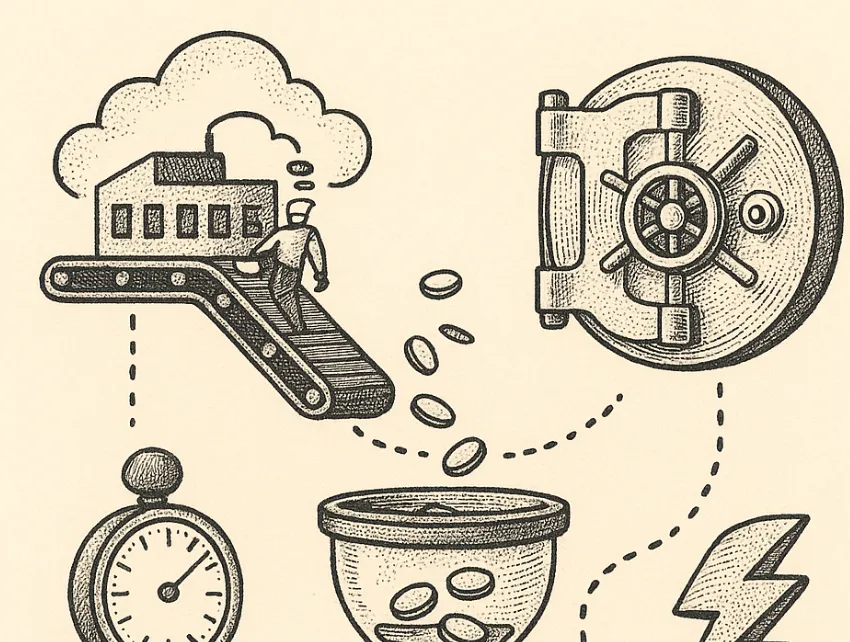
How to Pay Using Crypto: The 2025 Guide for Secure and Easy Transactions
Learn how to pay with crypto safely in 2025. Step-by-step guide to using Bitcoin, Ethereum, and stablecoins like USDC for fast, compliant payments.

.avif)
Paying with crypto isn’t just for early adopters anymore - it’s a fast, flexible, and increasingly common way to send money around the world.
Whether you’re a company paying a contractor overseas, an individual settling an invoice, or a business owner exploring crypto-friendly checkout options, the question isn’t if you can use crypto for payments - it’s how to do it right.
In 2025, over 15,000 businesses now accept cryptocurrency payments, from Shopify stores to major tech vendors. Meanwhile, stablecoins like USDC (which now power 70%+ of all crypto payment volume) are solving the biggest challenge: price volatility.
Crypto payments offer:
- Instant settlement (no 3-day bank waits)
- Lower fees (skip the intermediaries)
- Global reach (borderless and censorship-resistant)
But speed and accessibility alone aren’t enough. If you’re using crypto to pay vendors, employees, or service providers, you also need to get the compliance and security right.
This guide walks you through how to pay using crypto, from choosing a wallet to making a secure, tax-compliant transaction using BTC, ETH, or stablecoins like USDC. You’ll get actionable steps, tips, visual aids, and best practices to avoid mistakes - and we’ll show you why USDC is emerging as the safest and most practical payment method in 2025.
Let’s dive in.
Include short stat visual or chart (Bitcoin vs stablecoins usage 2020-2025).
How Crypto Payments Work
What Actually Happens When You Pay with Crypto?
At its core, a crypto payment is a peer-to-peer value transfer over a blockchain network. There’s no bank in the middle. No international wire. Just a secure, timestamped record of who sent what to whom - and when.
That means when you pay a freelancer in Argentina or buy software from a vendor in Singapore, you're using the same infrastructure: a global, decentralized payment network that confirms transactions transparently, in minutes or seconds.
What the Blockchain Actually Does
Here’s the simplified breakdown of how a blockchain confirms a crypto payment:
- Initiation: You enter the recipient's address, select the amount, and sign the transaction with your private key
- Broadcasting: The transaction is broadcast to the network (e.g., Ethereum, Solana).
- Validation: Validators or miners check the transaction for validity - enough funds, proper formatting, no double-spend.
- Confirmation: Once verified, the transaction is added to a block and permanently recorded on-chain.
- Settlement: The recipient sees the funds in their wallet, often within seconds (depending on the network).
Unlike banks, blockchains settle 24/7 - no waiting for “banking hours.”
But Crypto ≠ Just Bitcoin Anymore
A decade ago, most crypto payments used Bitcoin. Today, that’s changed.
Stablecoins like USDC and USDT now power a majority of real-world crypto transactions - especially across borders. Why? Because:
- They’re pegged to fiat (so you don’t lose value overnight).
- They settle instantly like crypto.
- And they integrate with both merchant checkouts and wallets.
USDC in particular has become the go-to asset for payroll, invoicing, and international B2B payments. It’s stable, regulated, and supported on multiple chains (Ethereum, Solana, Polygon).
The Benefits of Paying with Crypto
Why More Teams and Vendors Are Switching to Digital Currency
Crypto payments aren’t just about novelty or decentralization, they’re practical. Whether you're paying an international contractor, purchasing services online, or managing global payroll, crypto solves long-standing problems in speed, cost, and accessibility.
Here’s what makes crypto a compelling alternative to traditional payment rails in 2025:
Instant Settlement
No more waiting 3–5 business days for cross-border wires to clear. Most crypto transactions settle in seconds or minutes, even faster on networks like Solana or Polygon.
Lower Fees
Skip the banks, correspondent fees, and currency exchange markups. With crypto, you're only paying minimal network fees - often less than $0.01 on certain blockchains.
Global Access Without Gatekeepers
As long as both sender and receiver have a wallet, payments can happen anytime, anywhere - no need for local banks or Swift access. This levels the playing field for workers and businesses in underbanked regions.
Transparent and Auditable
All transactions are recorded on-chain, meaning you can verify payment history and confirm delivery instantly. This transparency builds trust between companies and contractors.
Optional Privacy
Depending on the blockchain and wallet used, users can preserve pseudonymity while still maintaining full transaction integrity.
Bonus: Why Stablecoins Like USDC Are the Real Game-Changer
Volatility has always been crypto’s Achilles’ heel - no one wants to get paid on Monday and lose 10% by Wednesday. But stablecoins like USDC remove that risk entirely.
USDC (USD Coin) is:
- Pegged 1:1 to the U.S. dollar
- Fully backed by audited reserves
- Issued by a regulated U.S. financial institution (Circle)
- Supported on major chains like Ethereum, Solana, and Polygon
That’s why 70%+ of crypto payment volume now uses stablecoins - they’re fast, stable, and easier to account for on balance sheets.
Security and Compliance Checklist When Paying in Crypto
How to Pay with Crypto Safely, Legally, and Without Regret
Crypto transactions are powerful, but with great speed comes great responsibility. A single wrong address, a phishing link, or a missed tax form can turn a simple payment into a costly mistake.
Here’s your essential checklist to ensure every crypto payment you make is secure, compliant, and audit-ready in 2025.
Double-Check the Wallet Address
Crypto payments are irreversible. Once you hit “send,” there’s no undo button. That’s why it’s critical to:
- Confirm every character of the recipient’s wallet address
- When possible, use QR codes or ENS names to reduce errors
- Send a small test transaction first before transferring large amounts
Tip: Consider using wallets with address-book functionality or address-verification popups.
Use Trusted Wallets and Merchants Only
Just like the web has phishing sites, the crypto world has scam wallets and fake payment portals. Stick to:
- Reputable wallets like Coinbase Wallet, Metamask, Trust Wallet, or Ledger
- Verified merchants using secure checkout providers (e.g., Coinbase Commerce, NOWPayments)
- HTTPS-only payment links and never click payment requests from unverified DMs
Tip: Check for transaction history or ENS verification when paying wallets you don’t recognize.
Keep Transaction Records and Receipts
Even though transactions live on the blockchain, maintaining your own records is essential - especially for compliance and tax season.
- Take screenshots of the transaction confirmation
- Export receipts from your wallet interface or block explorer (e.g., Etherscan)
- Store these in your accounting system or a dedicated payment log
Tip: Tools like Blockchair or Etherscan help you verify and export transactions by address or hash.
Understand Tax and Reporting Obligations
In most jurisdictions, crypto isn’t treated like cash, it’s taxed as property or digital assets. That means:
- You may owe capital gains if paying from an appreciating crypto wallet
- Businesses must account for cost basis, withholding, and reporting obligations
- Contractors may need to report payments as income depending on their jurisdiction
Tip: Consult with a crypto-savvy accountant. In the U.S., the IRS now requires reporting of digital asset transactions on Form 1099-DA.
Follow KYC/AML Best Practices (Especially for Businesses)
If you’re paying contractors or vendors at scale, especially across borders, you need to comply with:
- KYC (Know Your Customer): Verify recipient identities
- AML (Anti-Money Laundering): Monitor for suspicious activity
- Sanctions Compliance: Avoid sending to blacklisted jurisdictions
This is where platforms like Toku step in, automating global payments with full compliance baked in. Toku handles:
- SOC 2–certified security
- Real-time identity checks
- Tax withholding and reporting
- Geographic restrictions based on sanctions lists
Using Toku means you don’t have to build a global compliance engine from scratch.
Why Stablecoins Like USDC Make Payments Easier
Predictable. Programmable. Perfect for Payroll.
One of the biggest barriers to using cryptocurrency for everyday payments has always been volatility.
While assets like Bitcoin (BTC) and Ethereum (ETH) have paved the way for decentralized finance, their value can swing wildly, even within hours. That makes them risky for:
- Paying contractors
- Pricing services
- Managing recurring payments
For example: If you agree to pay someone $1,000 in BTC, but Bitcoin drops 5% overnight, your recipient might only receive $950 worth. Not ideal.
Why USDC Is Different
USD Coin (USDC) is a stablecoin - a type of cryptocurrency pegged 1:1 to the US dollar. Unlike BTC or ETH, its price doesn’t fluctuate.
What makes USDC ideal for payments:
- Always equal to $1 (fully reserved, audited monthly)
- Backed by cash and short-term Treasuries held by regulated institutions
- Supports fast settlement without the volatility headaches
- Runs on multiple networks like Ethereum, Solana, and Polygon
It’s the best of both worlds - crypto-level speed and programmability, with fiat-level price stability.
Stablecoins vs Traditional Crypto for Payments
Toku’s Role
Toku helps global companies simplify and scale their USDC payouts - while staying fully compliant in 100+ countries.
Toku automates:
- KYC (Know Your Customer)
- AML (Anti-Money Laundering)
- Tax reporting and regulatory filings
So you can pay contributors, employees, and contractors instantly and legally - without the overhead.
5 Common Ways to Pay Using Crypto
Real-World Use Cases for BTC, ETH, and USDC Payments
So how are people and businesses actually using crypto to pay in 2025? It’s no longer a fringe experiment. From e-commerce to international payroll, here are the most common real-world use cases for crypto payments:
1. Online Checkout
Thousands of merchants, including Shopify stores, VPNs, web hosts, and SaaS providers - now accept crypto at checkout using tools like:
- Coinbase Commerce
- NOWPayments
- OpenNode
- BTCPay Server (self-hosted)
These integrations allow users to pay in BTC, ETH, or stablecoins like USDC by simply connecting a wallet and confirming the transaction.
Pro tip: Use stablecoins for checkout if you want fiat-equivalent pricing without volatility risk.
2. In-Store QR Code Payments
In physical stores, QR code–based crypto payments are on the rise - especially in regions like Latin America, Southeast Asia, and parts of Europe. Customers simply scan a payment address via their wallet and send funds in seconds.
These point-of-sale setups are especially popular in retail and hospitality, enabling merchants to receive crypto without needing complex hardware.
3. Peer-to-Peer Transfers
The simplest and most common use case: sending funds directly from one wallet to another. Perfect for:
- Paying freelancers and contractors
- Splitting bills with friends
- Gifting crypto
P2P crypto transfers are borderless, instant, and often cheaper than PayPal or traditional banking, especially for international transfers.
4. Bill Pay and Subscriptions
Yes, you can even pay your Netflix or phone bill with crypto (depending on your region). Services like Bitrefill, Coinsbee, and Spritz offer indirect bill pay and gift card options in exchange for crypto.
While still growing, these tools hint at a future where subscription and utility payments may happen natively on-chain.
5. Cross-Border Payroll and Compensation
This is where crypto, especially stablecoins like USDC, really shines. Global payroll has historically been a headache: wires, FX fees, delays, compliance risks.
With stablecoin-powered payroll platforms like Toku, companies can now pay employees, contractors, and DAOs instantly - across 100+ countries while ensuring full tax and legal compliance.
Pro tip: If you're sending recurring payments to a distributed team, stablecoins like USDC are more practical than BTC or ETH.
The Benefits of Paying with Crypto
Why More People (and Companies) Are Making the Switch
So why go through the trouble of using crypto for payments? Whether you’re a freelancer, business owner, or payroll administrator, the benefits are clear:
Instant Settlement
Crypto settles in minutes or seconds, not days. No waiting for “business hours” or weekend delays. Your recipient sees the payment in their wallet almost immediately.
Lower Transaction Costs
Forget international wire fees or 3% credit card processing rates. Sending USDC or ETH on chains like Solana or Polygon can cost fractions of a cent.
Global Accessibility
Crypto is inherently borderless. Anyone with a phone and an internet connection can receive payments, no matter where they live, no bank account required.
Transparency and Auditability
Every crypto payment is traceable on-chain. This makes it easier to:
- Reconcile financial records
- Provide audit trails
- Detect fraud or errors
Plus, anyone with a transaction hash can verify payment in real time.
Optional Privacy
Depending on the chain and wallet setup, crypto allows for pseudonymous payments - offering more privacy than traditional systems, but still auditable if needed.
Stablecoin Advantage
Stablecoins like USDC combine all of the above - with the added benefit of price stability. They’re pegged to the dollar, making them ideal for:
- Invoicing
- Payroll
- Reimbursement
- Cross-border business payments
USDC is especially popular because it’s fully reserved, audited, and integrated across major chains.
FAQs About Paying With Crypto
Common Questions Answered
Let’s clear up some of the most frequent questions about crypto payments.
Is it safe to pay with crypto?
Yes, as long as you take basic precautions. Use trusted wallets, double-check addresses, and avoid phishing scams. Unlike bank transactions, there are no chargebacks - so accuracy matters.
Can I get a refund after sending crypto?
Usually no. Crypto transactions are irreversible once confirmed. Always verify recipient details and confirm amounts before sending. For refunds, you'll need to arrange a return transaction with the recipient.
Which cryptocurrencies are best for payments?
- BTC is widely accepted but volatile
- ETH is good for smart contract payments
- USDC is best for day-to-day payments due to its stability
Stablecoins are generally the safest bet for consistent value.
What’s the difference between paying in Bitcoin vs. USDC?
Are crypto payments taxable?
Yes. In many countries, crypto payments are considered taxable events. You may owe taxes depending on your location, payment type, and crypto gains/losses. Always consult a tax advisor.
The Future of Payments Is Stable - Why USDC Leads the Way
Crypto Rails. Dollar Stability. Compliance Built In.
As crypto matures, the way we pay is evolving - fast. The future isn’t about Bitcoin maximalism or meme coins at checkout. It’s about practical, programmable, and price-stable payments.
Stablecoins like USDC are already leading the charge. They offer:
- The speed and programmability of crypto
- The price predictability of dollars
- The global reach and efficiency traditional systems lack
Whether you’re paying a contractor, a DAO contributor, or your global team, you need more than just fast transactions. You need:
- Legal clarity
- KYC and AML checks
- Tax reporting
- Secure infrastructure
That’s where Toku comes in.
Simplify your global crypto payments. Try Toku for instant, compliant USDC transactions.







